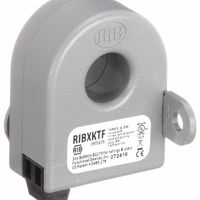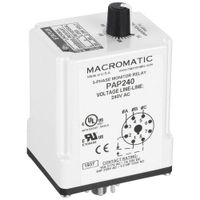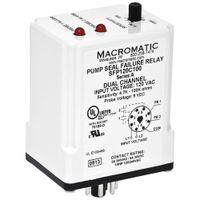Call +(254) 703 030 000 / 751 483 999 / 721 704 777
- Home
- Electrical
- Industrial Controls Automation And Machine Safety
- Relays
- Monitoring Relays
.....Read More
Frequently Asked Questions
What are the different types of monitoring relays and their functions?
1. **Voltage Monitoring Relays**: These relays monitor over-voltage, under-voltage, or phase imbalance in electrical systems. They protect equipment from voltage fluctuations that can cause damage or inefficiency.
2. **Current Monitoring Relays**: These devices detect over-current or under-current conditions. They are used to prevent equipment from drawing too much current, which can lead to overheating and damage.
3. **Phase Sequence Relays**: These relays ensure the correct sequence of phases in a three-phase system. Incorrect phase sequence can cause motors to run in reverse, leading to mechanical failures.
4. **Phase Loss Relays**: These detect the loss of one or more phases in a three-phase system. Phase loss can cause motors to overheat and fail, so these relays help prevent such occurrences.
5. **Frequency Monitoring Relays**: These relays monitor the frequency of the electrical supply. Deviations from the standard frequency can affect the performance of sensitive equipment.
6. **Temperature Monitoring Relays**: These devices monitor the temperature of equipment or environments. They are used to prevent overheating and ensure that systems operate within safe temperature ranges.
7. **Level Monitoring Relays**: These relays are used in applications like tank level monitoring. They detect the level of liquids or solids and can trigger alarms or control pumps to maintain desired levels.
8. **Insulation Monitoring Relays**: These relays monitor the insulation resistance of electrical systems. They help in detecting insulation failures that can lead to short circuits or electrical fires.
9. **Power Factor Monitoring Relays**: These devices monitor the power factor of electrical systems. Maintaining an optimal power factor is crucial for energy efficiency and reducing electricity costs.
10. **Earth Fault Monitoring Relays**: These relays detect earth faults in electrical systems, helping to prevent electrical shocks and equipment damage.
How do current-monitoring relays work?
Current-monitoring relays, also known as current-sensing relays, work by detecting the flow of electrical current in a circuit and responding to changes in that current. They are used to protect electrical equipment from overcurrent, undercurrent, or phase loss conditions. Here's how they function:
1. **Sensing Mechanism**: The relay uses a current transformer (CT) or a Hall effect sensor to measure the current flowing through a conductor. The CT converts the high current in the circuit to a lower, manageable level for the relay to process.
2. **Signal Processing**: The reduced current signal is then processed by the relay's internal circuitry. This circuitry compares the measured current against pre-set thresholds or parameters defined by the user.
3. **Threshold Comparison**: The relay is programmed with specific current limits. If the current exceeds or falls below these limits, the relay identifies this as an abnormal condition.
4. **Response Activation**: Upon detecting an abnormal current condition, the relay activates its output contacts. These contacts can be used to trigger alarms, shut down equipment, or signal a control system to take corrective action.
5. **Adjustability and Settings**: Many current-monitoring relays allow for adjustable settings, such as delay times and sensitivity levels, to prevent nuisance tripping and to tailor the relay's response to specific applications.
6. **Feedback and Indication**: Some relays provide visual or digital feedback, such as LED indicators or digital displays, to show the current status and any fault conditions.
By continuously monitoring the current, these relays help ensure the safe and efficient operation of electrical systems, preventing damage and downtime due to electrical faults.
What is the purpose of voltage-monitoring relays?
Voltage-monitoring relays are designed to protect electrical equipment and systems by continuously monitoring voltage levels and ensuring they remain within specified limits. Their primary purpose is to detect abnormal voltage conditions, such as over-voltage, under-voltage, phase loss, phase imbalance, and phase reversal, which can lead to equipment damage, operational inefficiencies, or safety hazards.
These relays are crucial in preventing damage to motors, transformers, and other sensitive electrical devices. By detecting voltage anomalies, they can trigger alarms or disconnect the power supply to prevent overheating, insulation breakdown, or mechanical stress. This proactive approach helps in minimizing downtime, reducing maintenance costs, and extending the lifespan of electrical equipment.
Voltage-monitoring relays are commonly used in industrial, commercial, and residential applications. In industrial settings, they protect machinery and production lines from voltage fluctuations that could disrupt operations. In commercial buildings, they ensure the stability of power supply to critical systems like HVAC, elevators, and lighting. In residential applications, they safeguard home appliances and electronics from voltage spikes or drops.
These relays can be configured to specific voltage thresholds and response times, allowing for tailored protection based on the requirements of the system they are safeguarding. They often include features like adjustable settings, LED indicators, and communication capabilities for integration with broader monitoring and control systems.
Overall, voltage-monitoring relays play a vital role in maintaining electrical system reliability, safety, and efficiency by providing continuous oversight and rapid response to voltage irregularities.
How do phase-monitoring relays detect abnormalities?
Phase-monitoring relays detect abnormalities by continuously monitoring the electrical parameters of a three-phase power system. They are designed to ensure the proper functioning of equipment by identifying issues such as phase loss, phase reversal, phase unbalance, and under/over-voltage conditions.
1. **Phase Loss Detection**: The relay monitors the voltage levels of each phase. If one phase drops below a preset threshold, indicating a loss of phase, the relay triggers an alarm or disconnects the load to prevent damage.
2. **Phase Reversal Detection**: The relay checks the sequence of the phases. If the order of the phases is incorrect, which can cause motors to run in reverse, the relay detects this reversal and initiates corrective actions.
3. **Phase Unbalance Detection**: The relay measures the voltage or current in each phase. An unbalance occurs when there is a significant difference between the phases. The relay calculates the percentage of unbalance and compares it to a set limit. If exceeded, it signals an abnormal condition.
4. **Under/Over-Voltage Detection**: The relay continuously measures the voltage levels of each phase. If the voltage falls below or rises above the set thresholds, the relay identifies this as an under-voltage or over-voltage condition and acts accordingly.
Phase-monitoring relays use microprocessors or analog circuits to perform these functions, providing real-time protection and ensuring the reliability and safety of electrical systems.
What applications use liquid-level monitoring relays?
Liquid-level monitoring relays are used in various applications to ensure the proper management and control of liquid levels in different environments. These applications include:
1. **Water Treatment Plants**: To monitor and control the levels of water in tanks and reservoirs, ensuring efficient water distribution and preventing overflow or dry running of pumps.
2. **Industrial Process Control**: In industries such as chemical, pharmaceutical, and food processing, liquid-level monitoring relays help maintain the correct levels of liquids in process tanks, ensuring product quality and process efficiency.
3. **HVAC Systems**: Used in heating, ventilation, and air conditioning systems to monitor and control the levels of water in cooling towers and boilers, preventing damage and ensuring efficient operation.
4. **Agriculture and Irrigation**: To manage water levels in irrigation systems, ensuring optimal water usage and preventing water wastage or crop damage due to over-irrigation.
5. **Oil and Gas Industry**: For monitoring levels in storage tanks and pipelines, preventing spills, and ensuring safe and efficient operation of equipment.
6. **Marine and Shipping**: Used in ships and submarines to monitor ballast and fuel tank levels, ensuring stability and operational efficiency.
7. **Wastewater Management**: To control the levels in sewage and wastewater treatment facilities, preventing overflow and ensuring compliance with environmental regulations.
8. **Fire Protection Systems**: In fire suppression systems, to ensure that water tanks are adequately filled and ready for emergency use.
9. **Beverage and Brewing Industry**: To maintain the correct levels of liquids in fermentation and storage tanks, ensuring product consistency and quality.
10. **Automotive Industry**: Used in vehicle manufacturing and maintenance to monitor fluid levels in various systems, such as coolant and brake fluid reservoirs.
How do seal-leakage monitoring relays protect submersible pumps?
Seal-leakage monitoring relays protect submersible pumps by detecting the presence of moisture or water ingress in the motor housing, which can indicate a failure in the pump's sealing system. These relays are connected to sensors placed within the pump's seal chamber. When the seal begins to fail, water or moisture enters the chamber, altering the electrical resistance or capacitance detected by the sensors.
The relay continuously monitors these changes. If the resistance or capacitance deviates from the normal range, indicating moisture presence, the relay triggers an alarm or shuts down the pump to prevent further damage. This early detection helps in preventing catastrophic failures, reducing downtime, and minimizing repair costs.
By providing real-time monitoring, seal-leakage relays ensure that maintenance can be scheduled proactively, rather than reactively, thus extending the lifespan of the pump. They are crucial in applications where pumps are used in harsh or remote environments, as they provide an additional layer of protection against unexpected failures.
What are the benefits of using temperature-monitoring relays?
Temperature-monitoring relays offer several benefits:
1. **Equipment Protection**: They prevent overheating by monitoring temperature levels and triggering alarms or shutdowns when thresholds are exceeded, protecting motors, transformers, and other equipment from damage.
2. **Increased Safety**: By detecting abnormal temperature rises, they help prevent fires and other hazards, ensuring a safer working environment.
3. **Extended Equipment Life**: By maintaining optimal operating temperatures, these relays reduce wear and tear, thereby extending the lifespan of equipment.
4. **Energy Efficiency**: They help maintain efficient operation by ensuring equipment runs within specified temperature ranges, reducing energy consumption and costs.
5. **Reduced Downtime**: Early detection of temperature anomalies allows for timely maintenance, minimizing unexpected breakdowns and associated downtime.
6. **Cost Savings**: Preventing equipment damage and reducing downtime lead to significant cost savings in repairs and lost productivity.
7. **Versatility**: Suitable for various applications, including HVAC systems, industrial machinery, and electrical panels, they offer broad utility across industries.
8. **Data Logging and Analysis**: Many modern relays provide data logging capabilities, enabling trend analysis and predictive maintenance strategies.
9. **Remote Monitoring**: Advanced models offer remote monitoring and control, allowing for real-time temperature management from a distance.
10. **Compliance**: They help ensure compliance with safety and operational standards, which is crucial for regulatory adherence.
11. **User-Friendly**: Typically easy to install and configure, they integrate seamlessly into existing systems without requiring extensive modifications.
12. **Customizable Settings**: Users can set specific temperature thresholds and response actions, tailoring the system to specific operational needs.
Overall, temperature-monitoring relays are essential for maintaining operational efficiency, safety, and reliability in various industrial and commercial applications.







